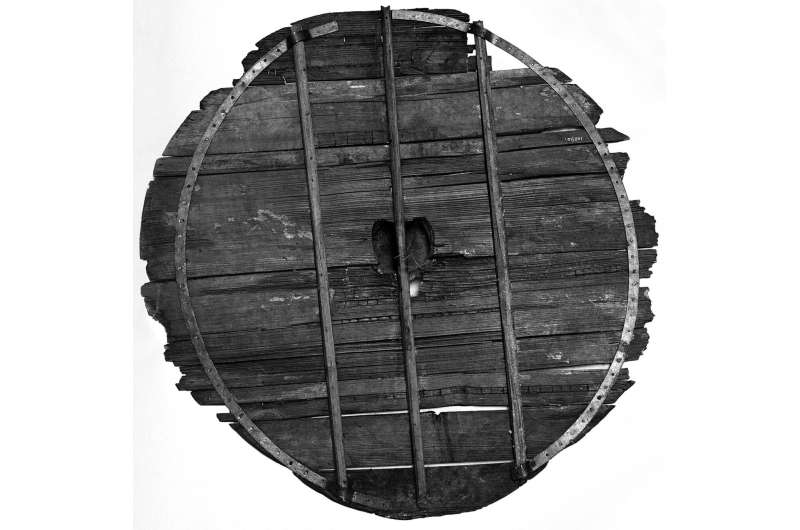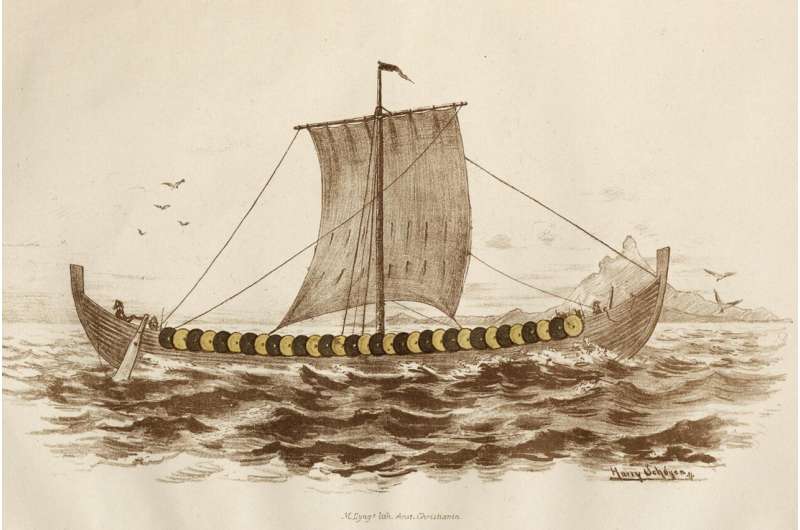
Rolf Fabricius Warming from the Department of Archaeology and Classical Studies at Stockholm University in Sweden and founding director of the Society for Combat Archaeology is challenging previous interpretations of ceremonial shields found in a Viking Age longship burial mound. His research is published in the journal Arms & Armour.
About 1,100 years ago, at Gokstad in Vestfold, Norway, an important man was laid to rest in a 78-foot-long longship. The Gokstad ship was buried along with a few luxury possessions, including gold-embroidered tapestries, a sleigh, a saddle, 12 horses, eight dogs, two peacocks, six beds and 64 round shields as well as three smaller boats on the deck. The ship and the grave goods remained undisturbed under a mound of earth until it was discovered in 1880. Warming notes that while the longship and many artifacts now rest in a museum in Norway, some of the grave goods had not been subjected to any substantial examination since their initial discovery.
This can often be the case with museum pieces, long displayed behind glass with a small placard of text describing the artifact in certain terms, and it can be challenging to argue with the gravitas of the presentation. More often, artifacts or fossils are rediscovered in museum or university basements, a last-ditch effort to identify items in a box decades after the initial discovery often comes with discovery based on decades of new knowledge. Since the Gokstad ship discovery was more than 140 years ago, a new look was overdue.
Having researched Viking Age shield manufacturing in Denmark, Warming specifically focused on the 64 round shields that the original assessment considered constructed for a burial rite ceremony. Warming investigated the fragmented wooden shield boards contained in 50 boxes at the Viking Ship Museum in Oslo. Four shields had undergone a crude reconstruction about a hundred years ago, reinforced with modern steel frames and constructed from original boards, though according to Warming, not boards belonging to a single shield but rather as aesthetic museum reconstructions.

The original report by Norwegian archaeologist Nicolay Nicolaysen in 1882 states that 32 shields were found hung on each side of the ship. They were painted either in yellow or black and positioned in alternating colors so that the rim of each shield touched the boss (the round metal connecting piece in the center of the shields) of the next, giving the rows of shields an appearance of yellow and black half-moons. The shields were not intact, and only minor pieces of the shield boards were found in their original position.
According to the current study, the original report left out critical details. Shield bosses and boards, while mentioned by Nicolaysen, were not counted in the report and the pigments described are no longer visible or even detectable on the artifacts.
The shields were found to have small holes around the circumference, which the original report assumed were used for fastening a metallic rim that had corroded away before discovery. Warming updates this interpretation with a much richer body of literature available on round shields than at the time of the excavation.
The hypothesized missing metallic rims have not been discovered in other Viking Age shields, but more likely were attachment points for thin, parchment-like rawhide covers as discovered on shield finds in Denmark, Sweden and Latvia. Several boards with patches of unidentified organic material may offer some clarity in future investigations. The presence of animal skins on shields would indicate functional constructions for use in combat. Warming also hints that this parchment could have been painted, which might explain why pigments have not been detected on the board fragments as a thin organic covering might not have survived.
An iron shield handle, covered with a very thin decorative copper alloy sheet, bent around the iron core, masking rivets hidden underneath is among the artifacts. Additionally, some of the shield fragments also have small holes on either side of cracks in the boards, suggesting they may have undergone repair. Both features inconsistent with ceremonial construction.
All of the shields were ultimately used in a ceremonial burial rite for the important figure entombed within the ship, but the construction and previous uses of the shields according to Warming are not as straight forward as originally reported.
Archaeology in general has a good track record for rewriting history and upending previous preconceptions of the past. As Warming demonstrates in his analysis, this can also be applied to past archaeological efforts. In essence, archaeological reports can have expiration dates. As new knowledge is acquired and analysis techniques become available there are untold discoveries awaiting more insightful inquiry of artifacts sitting patiently beside incorrect or incomplete placards in museums around the world.
More information: Rolf Fabricius Warming, The Viking Age shields from the ship burial at Gokstad: a re-examination of their construction and function, Arms & Armour (2023). DOI: 10.1080/17416124.2023.2187199
© 2023 Science X Network
Citation: Viking Age ceremonial burial shields found to be combat ready (2023, April 6) retrieved 6 April 2023 from https://ift.tt/nJWad60
This document is subject to copyright. Apart from any fair dealing for the purpose of private study or research, no part may be reproduced without the written permission. The content is provided for information purposes only.
"original" - Google News
April 06, 2023 at 09:20PM
https://ift.tt/YaPevIZ
Viking Age ceremonial burial shields found to be combat ready - Phys.org
"original" - Google News
https://ift.tt/y0MdGL3
https://ift.tt/TREDqwn
Bagikan Berita Ini














0 Response to "Viking Age ceremonial burial shields found to be combat ready - Phys.org"
Post a Comment